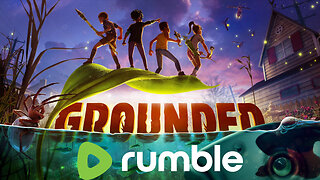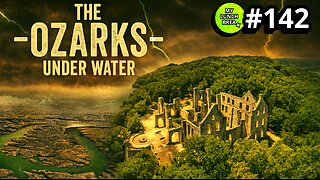Premium Only Content

Earth views
The Earth, when viewed from space, presents a breathtaking and awe-inspiring sight. Astronauts and satellites provide us with a unique perspective of our planet that highlights its beauty, fragility, and interconnectedness. Here's a description of what Earth looks like from space:
1. The Blue Marble: The most striking feature of the Earth from space is its deep blue oceans that cover more than 70% of the planet's surface. The oceans appear as vibrant shades of blue, ranging from sapphire to turquoise, and their vastness is both mesmerizing and humbling.
2. Continents and Landmasses: Scattered across the blue expanse are the continents and landmasses. These continents are characterized by a mix of various landforms, including mountains, valleys, deserts, forests, and plains. From space, you can see the contrast between the lush green of forests, the golden hues of deserts, and the white caps of snow-covered peaks.
3. Atmosphere and Thin Blue Halo: The Earth is surrounded by a thin layer of atmosphere that appears as a delicate, pale blue halo. This atmospheric layer is essential for sustaining life on the planet and protecting it from the harsh environment of space. It gradually fades into the blackness of space, reminding us of the delicate balance that exists to support life.
4. Cloud Cover: Clouds swirl and float above the Earth's surface, casting ever-changing patterns of shadow and light. These clouds are a testament to the dynamic nature of the planet's weather systems. They can be fluffy and white, or thick and dark, depending on the altitude and weather conditions.
5. Urban Lights: At night, the Earth's surface comes alive with the twinkling lights of cities, towns, and industrial areas. This illumination showcases the extent of human habitation and activity across the planet. Urban centers stand out as clusters of bright spots, connected by networks of illuminated roads and infrastructure.
6. Polar Ice Caps: The polar ice caps, located at the North and South Poles, are visible from space. These vast expanses of ice and snow create a stark contrast against the surrounding land and water, offering
The Earth, when viewed from space, presents a breathtaking and awe-inspiring sight. Astronauts and satellites provide us with a unique perspective of our planet that highlights its beauty, fragility, and interconnectedness. Here's a description of what Earth looks like from space:
1. The Blue Marble: The most striking feature of the Earth from space is its deep blue oceans that cover more than 70% of the planet's surface. The oceans appear as vibrant shades of blue, ranging from sapphire to turquoise, and their vastness is both mesmerizing and humbling.
2. Continents and Landmasses: Scattered across the blue expanse are the continents and landmasses. These continents are characterized by a mix of various landforms, including mountains, valleys, deserts, forests, and plains. From space, you can see the contrast between the lush green of forests, the golden hues of deserts, and the white caps of snow-covered peaks.
3. Atmosphere and Thin Blue Halo: The Earth is surrounded by a thin layer of atmosphere that appears as a delicate, pale blue halo. This atmospheric layer is essential for sustaining life on the planet and protecting it from the harsh environment of space. It gradually fades into the blackness of space, reminding us of the delicate balance that exists to support life.
4. Cloud Cover: Clouds swirl and float above the Earth's surface, casting ever-changing patterns of shadow and light. These clouds are a testament to the dynamic nature of the planet's weather systems. They can be fluffy and white, or thick and dark, depending on the altitude and weather conditions.
5. Urban Lights: At night, the Earth's surface comes alive with the twinkling lights of cities, towns, and industrial areas. This illumination showcases the extent of human habitation and activity across the planet. Urban centers stand out as clusters of bright spots, connected by networks of illuminated roads and infrastructure.
6. Polar Ice Caps: The polar ice caps, located at the North and South Poles, are visible from space. These vast expanses of ice and snow create a stark contrast against the surrounding land and water, offering
The Earth, when viewed from space, presents a breathtaking and awe-inspiring sight. Astronauts and satellites provide us with a unique perspective of our planet that highlights its beauty, fragility, and interconnectedness. Here's a description of what Earth looks like from space:
1. The Blue Marble: The most striking feature of the Earth from space is its deep blue oceans that cover more than 70% of the planet's surface. The oceans appear as vibrant shades of blue, ranging from sapphire to turquoise, and their vastness is both mesmerizing and humbling.
2. Continents and Landmasses: Scattered across the blue expanse are the continents and landmasses. These continents are characterized by a mix of various landforms, including mountains, valleys, deserts, forests, and plains. From space, you can see the contrast between the lush green of forests, the golden hues of deserts, and the white caps of snow-covered peaks.
3. Atmosphere and Thin Blue Halo: The Earth is surrounded by a thin layer of atmosphere that appears as a delicate, pale blue halo. This atmospheric layer is essential for sustaining life on the planet and protecting it from the harsh environment of space. It gradually fades into the blackness of space, reminding us of the delicate balance that exists to support life.
4. Cloud Cover: Clouds swirl and float above the Earth's surface, casting ever-changing patterns of shadow and light. These clouds are a testament to the dynamic nature of the planet's weather systems. They can be fluffy and white, or thick and dark, depending on the altitude and weather conditions.
5. Urban Lights: At night, the Earth's surface comes alive with the twinkling lights of cities, towns, and industrial areas. This illumination showcases the extent of human habitation and activity across the planet. Urban centers stand out as clusters of bright spots, connected by networks of illuminated roads and infrastructure.
6. Polar Ice Caps: The polar ice caps, located at the North and South Poles, are visible from space. These vast expanses of ice and snow create a stark contrast against the surrounding land and water, offering
The Earth, when viewed from space, presents a breathtaking and awe-inspiring sight. Astronauts and satellites provide us with a unique perspective of our planet that highlights its beauty, fragility, and interconnectedness. Here's a description of what Earth looks like from space:
1. The Blue Marble: The most striking feature of the Earth from space is its deep blue oceans that cover more than 70% of the planet's surface. The oceans appear as vibrant shades of blue, ranging from sapphire to turquoise, and their vastness is both mesmerizing and humbling.
2. Continents and Landmasses: Scattered across the blue expanse are the continents and landmasses. These continents are characterized by a mix of various landforms, including mountains, valleys, deserts, forests, and plains. From space, you can see the contrast between the lush green of forests, the golden hues of deserts, and the white caps of snow-covered peaks.
3. Atmosphere and Thin Blue Halo: The Earth is surrounded by a thin layer of atmosphere that appears as a delicate, pale blue halo. This atmospheric layer is essential for sustaining life on the planet and protecting it from the harsh environment of space. It gradually fades into the blackness of space, reminding us of the delicate balance that exists to support life.
4. Cloud Cover: Clouds swirl and float above the Earth's surface, casting ever-changing patterns of shadow and light. These clouds are a testament to the dynamic nature of the planet's weather systems. They can be fluffy and white, or thick and dark, depending on the altitude and weather conditions.
5. Urban Lights: At night, the Earth's surface comes alive with the twinkling lights of cities, towns, and industrial areas. This illumination showcases the extent of human habitation and activity across the planet. Urban centers stand out as clusters of bright spots, connected by networks of illuminated roads and infrastructure.
6. Polar Ice Caps: The polar ice caps, located at the North and South Poles, are visible from space. These vast expanses of ice and snow create a stark contrast against the surrounding land and water, offering
The Earth, when viewed from space, presents a breathtaking and awe-inspiring sight. Astronauts and satellites provide us with a unique perspective of our planet that highlights its beauty, fragility, and interconnectedness. Here's a description of what Earth looks like from space:
1. The Blue Marble: The most striking feature of the Earth from space is its deep blue oceans that cover more than 70% of the planet's surface. The oceans appear as vibrant shades of blue, ranging from sapphire to turquoise, and their vastness is both mesmerizing and humbling.
2. Continents and Landmasses: Scattered across the blue expanse are the continents and landmasses. These continents are characterized by a mix of various landforms, including mountains, valleys, deserts, forests, and plains. From space, you can see the contrast between the lush green of forests, the golden hues of deserts, and the white caps of snow-covered peaks.
3. Atmosphere and Thin Blue Halo: The Earth is surrounded by a thin layer of atmosphere that appears as a delicate, pale blue halo. This atmospheric layer is essential for sustaining life on the planet and protecting it from the harsh environment of space. It gradually fades into the blackness of space, reminding us of the delicate balance that exists to support life.
4. Cloud Cover: Clouds swirl and float above the Earth's surface, casting ever-changing patterns of shadow and light. These clouds are a testament to the dynamic nature of the planet's weather systems. They can be fluffy and white, or thick and dark, depending on the altitude and weather conditions.
5. Urban Lights: At night, the Earth's surface comes alive with the twinkling lights of cities, towns, and industrial areas. This illumination showcases the extent of human habitation and activity across the planet. Urban centers stand out as clusters of bright spots, connected by networks of illuminated roads and infrastructure.
6. Polar Ice Caps: The polar ice caps, located at the North and South Poles, are visible from space. These vast expanses of ice and snow create a stark contrast against the surrounding land and water, offering
The Earth, when viewed from space, presents a breathtaking and awe-inspiring sight. Astronauts and satellites provide us with a unique perspective of our planet that highlights its beauty, fragility, and interconnectedness. Here's a description of what Earth looks like from space:
1. The Blue Marble: The most striking feature of the Earth from space is its deep blue oceans that cover more than 70% of the planet's surface. The oceans appear as vibrant shades of blue, ranging from sapphire to turquoise, and their vastness is both mesmerizing and humbling.
2. Continents and Landmasses: Scattered across the blue expanse are the continents and landmasses. These continents are characterized by a mix of various landforms, including mountains, valleys, deserts, forests, and plains. From space, you can see the contrast between the lush green of forests, the golden hues of deserts, and the white caps of snow-covered peaks.
3. Atmosphere and Thin Blue Halo: The Earth is surrounded by a thin layer of atmosphere that appears as a delicate, pale blue halo. This atmospheric layer is essential for sustaining life on the planet and protecting it from the harsh environment of space. It gradually fades into the blackness of space, reminding us of the delicate balance that exists to support life.
4. Cloud Cover: Clouds swirl and float above the Earth's surface, casting ever-changing patterns of shadow and light. These clouds are a testament to the dynamic nature of the planet's weather systems. They can be fluffy and white, or thick and dark, depending on the altitude and weather conditions.
5. Urban Lights: At night, the Earth's surface comes alive with the twinkling lights of cities, towns, and industrial areas. This illumination showcases the extent of human habitation and activity across the planet. Urban centers stand out as clusters of bright spots, connected by networks of illuminated roads and infrastructure.
6. Polar Ice Caps: The polar ice caps, located at the North and South Poles, are visible from space. These vast expanses of ice and snow create a stark contrast against the surrounding land and water, offering
The Earth, when viewed from space, presents a breathtaking and awe-inspiring sight. Astronauts and satellites provide us with a unique perspective of our planet that highlights its beauty, fragility, and interconnectedness. Here's a description of what Earth looks like from space:
1. The Blue Marble: The most striking feature of the Earth from space is its deep blue oceans that cover more than 70% of the planet's surface. The oceans appear as vibrant shades of blue, ranging from sapphire to turquoise, and their vastness is both mesmerizing and humbling.
2. Continents and Landmasses: Scattered across the blue expanse are the continents and landmasses. These continents are characterized by a mix of various landforms, including mountains, valleys, deserts, forests, and plains. From space, you can see the contrast between the lush green of forests, the golden hues of deserts, and the white caps of snow-covered peaks.
3. Atmosphere and Thin Blue Halo: The Earth is surrounded by a thin layer of atmosphere that appears as a delicate, pale blue halo. This atmospheric layer is essential for sustaining life on the planet and protecting it from the harsh environment of space. It gradually fades into the blackness of space, reminding us of the delicate balance that exists to support life.
4. Cloud Cover: Clouds swirl and float above the Earth's surface, casting ever-changing patterns of shadow and light. These clouds are a testament to the dynamic nature of the planet's weather systems. They can be fluffy and white, or thick and dark, depending on the altitude and weather conditions.
5. Urban Lights: At night, the Earth's surface comes alive with the twinkling lights of cities, towns, and industrial areas. This illumination showcases the extent of human habitation and activity across the planet. Urban centers stand out as clusters of bright spots, connected by networks of illuminated roads and infrastructure.
6. Polar Ice Caps: The polar ice caps, located at the North and South Poles, are visible from space. These vast expanses of ice and snow create a stark contrast against the surrounding land and water, offeringThe Earth, when viewed from space, presents a breathtaking and awe-inspiring sight. Astronauts and satellites provide us with a unique perspective of our planet that highlights its beauty, fragility, and interconnectedness. Here's a description of what Earth looks like from space:
-
 LIVE
LIVE
Barry Cunningham
4 hours agoPRESIDENT TRUMP ANNOUNCES THE CHIPOCALYPSE! AND I'M HERE FOR IT! (AND MORE NEWS)
5,646 watching -
 LIVE
LIVE
SpartakusLIVE
3 hours agoVerdansk Duos w/ Nicky || Saturday Spartoons - Variety Later?!
381 watching -
 LIVE
LIVE
SavageJayGatsby
1 day agoSpicy Saturday | Let's Play: Grounded
59 watching -
 13:37
13:37
Exploring With Nug
7 hours ago $1.41 earnedTrying to Uncover Secrets in St Augustine’s Waters Missing Person Search!
6.27K1 -
 LIVE
LIVE
Mally_Mouse
1 day ago🔥🍺Spicy HYDRATE Saturday!🍺🔥-- Let's Play: Grounded
59 watching -
 24:09
24:09
MYLUNCHBREAK CHANNEL PAGE
1 day agoDams Destroyed The Ozarks
60.6K25 -
 1:32:54
1:32:54
Jeff Ahern
5 hours ago $24.39 earnedThe Saturday Show with Jeff Ahern
83.3K9 -
 LIVE
LIVE
TheManaLord Plays
7 hours agoMANA SUMMIT - DAY 1 ($10,200+) | BANNED PLAYER SMASH MELEE INVITATIONAL
213 watching -
 LIVE
LIVE
Major League Fishing
2 days agoLIVE Tackle Warehouse Invitationals Championship, Day 2
132 watching -

GamerGril
4 hours agoScream Queens 💕 Goth & Gore 💕 Unpossess
17.1K2